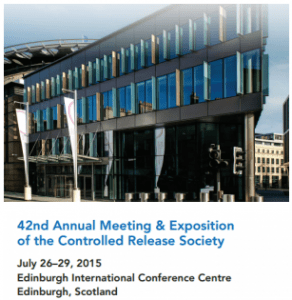Young Scientist Travel Award to Edinburgh, Scotland in 2015

ATA Scientific would like to thank all those that participated in our October 2014 Travel Award promotion. Our winner was selected by a panel of office bearers from the local CRS chapters and announced during the recent Australian & New Zealand CRS student workshop held in Adelaide (23 & 24 Oct 2014).
Congratulations to Nicolas Alcaraz, (PhD candidate, Monash Institute of Pharmaceutical Sciences) for winning our Young Scientist Travel Award. The award includes a $2000 contribution for travel costs to attend the 42nd Annual Meeting & Exposition of the Controlled Release Society, July 26-29, 2015 in Edinburgh, Scotland. A copy of the winning entry can be found below.

“Please find below the abstract for the poster I plan to present at the Edinburgh meeting in 2015 for the CRS and also why this subject is both relevant and novel:
Targeting drugs and imaging agents to specific tissues has always been of interest as it enables a new method to improve drug efficacy and visualisation of tissues and processes. Recent approaches have involved seeking covalent attachments of probes to cells with metabolic labelling. Metabolic labelling involves the labelling of a cell, through surface expression of a functional group, by taking advantage of its natural metabolic pathways. Sugars are generally taken up by cells and once metabolised expressed on the cell surface as part of glycoproteins. These sugars can be modified such that a functional group of interest is also expressed on the cell surface. Commonly the group used on these unnatural sugars is an azide as it is small, not biologically active and biologically safe. A probe can be attached to the azide group on the cell surface through specific reactions known as copper-free click chemistry.
Copper-free click chemistry involves using two functional groups that will react spontaneously and quickly to form a covalent bond. The most common reaction is an azide sugar reacting with a strained cyclooctyne that has an alkyne group. Previous studies have employed a functionalised dye that can be imaged using microscopy based techniques allowing f or specific imaging of cells and sugar related biological processes. Currently, these two techniques have been used together primarily for imaging purposes. A novel approach that involves using these two techniques together to allow for selective and specific targeting of cells by particles of interest will be tested. These particles may be drug delivery systems such as liquid crystal lipid systems.
These potential alternative uses will be examined and investigated. If possible this may lead to a new treatment method for diseases such as cancer. A proof of concept study was carried out at the Australian Synchrotron using Small Angle X-ray Scattering (SAXS) to determine if click chemistry could attach a drug delivery system to a surface. The study involved coating a quartz cover slip with a modified strained cyclooctyne. Azide-Phytantriol cubosomes were then added to the surface and SAXS was used to determine the liquid crystalline structure on the surface. The preliminary results are positive and the work will proceed into cells. This presentation will be relevant to the CRS meeting as not only does the work involve targeted drug delivery but also the ability to control drug release at the site leading to improvements to current treatments. Additionally, to the best of our knowledge this concept of using metabolic labelling and copper-free click chemistry as a method of drug delivery is novel and has not been attempted previously.”
For more information or to stay informed of other upcoming promotions please ‘Like us” on Facebook or contact us.




 02 9541 3500
02 9541 3500